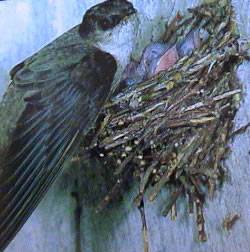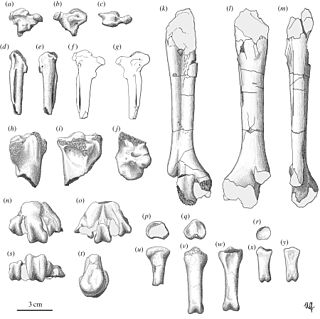
A goose is a bird of any of several waterfowl species in the family Anatidae. This group comprises the genera Anser and Branta. Some members of the Tadorninae subfamily are commonly called geese, but are not considered "true geese" taxonomically. More distantly related members of the family Anatidae are swans, most of which are larger than true geese, and ducks, which are smaller.

The nene, also known as the nēnē or the Hawaiian goose, is a species of bird endemic to the Hawaiian Islands. The nene is exclusively found in the wild on the islands of Oahu, Maui, Kauaʻi, Molokai, and Hawaiʻi. In 1957, it was designated as the official state bird of the state of Hawaiʻi.

The barnacle goose is a species of goose that belongs to the genus Branta of black geese, which contains species with largely black plumage, distinguishing them from the grey Anser species. Despite its superficial similarity to the brant goose, genetic analysis has shown it is an eastern derivative of the cackling goose lineage.

The red-breasted goose is a brightly marked species of goose in the genus Branta from Eurasia. It is currently classified as vulnerable by the IUCN.

The Anatidae are the biological family of water birds that includes ducks, geese, and swans. The family has a cosmopolitan distribution, occurring on all the world's continents except Antarctica. These birds are adapted for swimming, floating on the water surface, and, in some cases, diving in at least shallow water. The family contains around 174 species in 43 genera.

The Canada goose is a large wild goose with a black head and neck, white cheeks, white under its chin, and a brown body. It is native to the arctic and temperate regions of North America, and it is occasionally found during migration across the Atlantic in northern Europe. It has been introduced to France, the United Kingdom, Ireland, Finland, Sweden, Denmark, New Zealand, Japan, Chile, Argentina, and the Falkland Islands. Like most geese, the Canada goose is primarily herbivorous and normally migratory; often found on or close to fresh water, the Canada goose is also common in brackish marshes, estuaries, and lagoons.

The magpie goose is the sole living representative species of the family Anseranatidae. This common waterbird is found in northern Australia and southern New Guinea. As the species is prone to wandering, especially when not breeding, it is sometimes recorded outside its core range. The species was once also widespread in southern Australia but disappeared from there largely due to the drainage of the wetlands where the birds once bred. Due to their importance to Aboriginal people as a seasonal food source, as subjects of recreational hunting, and as a tourist attraction, their expansive and stable presence in northern Australia has been "ensured [by] protective management".

Anseranatidae, the magpie-geese, is a biological family of waterbirds. The only living species, the magpie goose, is a resident breeder in northern Australia and in southern New Guinea.

The black geese of the genus Branta are waterfowl belonging to the true geese and swans subfamily Anserinae. They occur in the northern coastal regions of the Palearctic and all over North America, migrating to more southerly coasts in winter, and as resident birds in the Hawaiian Islands. Alone in the Southern Hemisphere, a self-sustaining feral population derived from introduced Canada geese is also found in New Zealand.

The cackling goose is a species of goose found in North America and East Asia.

The brant or brent goose is a small goose of the genus Branta. There are three subspecies, all of which winter along temperate-zone sea-coasts and breed on the high-Arctic tundra.

The small bird genus Geronticus belongs to the ibis subfamily Threskiornithinae. Its name is derived from the Greek gérontos in reference to the bald head of these dark-plumaged birds; in English, they are called bald ibises.

Anser is a waterfowl genus that includes the grey geese and the white geese. It belongs to the true goose and swan subfamily of Anserinae under the family of Anatidae. The genus has a Holarctic distribution, with at least one species breeding in any open, wet habitats in the subarctic and cool temperate regions of the Northern Hemisphere in summer. Some also breed farther south, reaching into warm temperate regions. They mostly migrate south in winter, typically to regions in the temperate zone between the January 0 °C (32 °F) and 5 °C (41 °F) isotherms.

Chaetura is a genus of needletail swifts found in the Americas. Although they resemble swallows, the two are not at all closely related; this is instead a result of convergent evolution. Some members of Chaetura are long-distance migrants, while others are year-round residents.
Paleontology or palaeontology is the study of prehistoric life forms on Earth through the examination of plant and animal fossils. This includes the study of body fossils, tracks (ichnites), burrows, cast-off parts, fossilised feces (coprolites), palynomorphs and chemical residues. Because humans have encountered fossils for millennia, paleontology has a long history both before and after becoming formalized as a science. This article records significant discoveries and events related to paleontology that occurred or were published in the year 1998.
Eoanseranas handae, also sometimes referred to as Hand's dawn magpie goose, is an extinct genus and species of bird. Allied to the family Anseranatidae, which are represented by modern magpie geese, it existed during the Late Oligocene or Early Miocene of northern Australia. It was described from fossil material found at a Carl Creek Limestone site at Riversleigh, in the Boodjamulla National Park of northwestern Queensland. It was slightly smaller than its perceived descendant, the extant magpie goose Anseranas semipalmata.

Garganornis is an extinct genus of enormous flightless anatid waterfowl from the Late Miocene of Gargano, Italy. The genus contains one species, G. ballmanni, named by Meijer in 2014. Its enormous size is thought to have been an adaptation to living in exposed, open areas with no terrestrial predators, and as a deterrent to the indigenous aerial predators like the eagle Garganoaetus and the giant barn owl Tyto gigantea.
Patagorhacos is an extinct genus of medium-sized phorusrhacid from the early Miocene of Patagonia. Currently only the single species Patagorhacos terrificus is known, which is represented by two highly fragmentary specimen, one belonging to the back of the skull and the other being the distal end of a leg bone. It was described together with the contemporary rheid Opisthodactylus horacioperezi.
Notochen, also called the Bannockburn swan, is an extinct genus of anatid bird from the Early Miocene Bannockburn Formation of Otago, New Zealand. The genus contains a single species, Notochen bannockburnensis, known from various fossil material.
Anser thraciensis is an extinct species of water bird belonging to the living genus Anser. It was first named by Burchak-Abramovich and Nikolov (1984) from Trojanovo, Bulgaria. They also named Phalacrocorax serdicensis in the publication, from the same locality. The National Museum of Natural History, Sofia notes that 17 specimens of this taxon are presently held in their collections, catalogued as NMNHS 1407-1420, 1622-1625, and 1650-1652.














